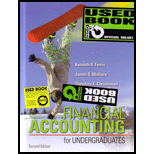
(a)
Prepare
(a)
Explanation of Solution
Bonds: Bonds are long-term promissory notes that are issued by a company while borrowing money from investors to raise fund for financing the operations.
Premium on bonds payable: It occurs when the bonds are issued at a higher price than the face value.
Prepare the following journal entry to record in the books of Company K:
| Date | Accounts title and Explanations | Debit ($) | Credit ($) | |
| 2009 | ||||
| December | 31 | Cash | 446,372 | |
| Bonds Payable | 400,000 | |||
| Premium on Bonds Payable (1) | 46,372 | |||
| (To record issue of bonds at premium) | ||||
Table (1)
- Cash is an asset account and it is increased. Therefore debit cash account by $446,372.
- Bonds Payable is a liability and it is increased. Therefore credit bonds payable account by $400,000.
- Premium on Bonds Payable is an adjunct account and it has a normal credit balance; therefore, credit Premium on Bonds Payable account by $46,372.
Working Notes:
Calculate premium on bonds payable.
(b)
Journalize the payment of interest and amortization of premium on bonds on June 30, 2010.
(b)
Explanation of Solution
Prepare the following journal entry to record in the books of Company K:
| Date | Accounts title and Explanations | Debit ($) | Credit ($) | |
| 2010 | ||||
| June | 30 | Bond Interest Expense (2) | 22,319 | |
| Premium on Bonds Payable (3) | 3,681 | |||
| Cash | 26,000 | |||
| (To record the payment of interest and amortization of premium) | ||||
Table (2)
- Interest Expense is a component of
stockholders equity. There is an increase in the expense account which decreased the stockholders’ equity. Therefore, debit interest expense account by $22,319. - Premium on Bonds payable is a contra liability account. The amount is decreased since the premium is amortized therefore; debit Premium on Bonds Payable account by $3,681.
- Cash is an asset account and it is decreased. Therefore credit cash account by $26,000.
Working Notes:
Calculate amount of interest payable.
Note: Time period = 6 months (December 31, 2009 to June 30, 2010)
Calculate amount of interest expense.
Note: Market interest rate = 10%
Calculate premium amortized.
(c)
Journalize the payment of interest and amortization of premium on bonds on December 31, 2010.
(c)
Explanation of Solution
Prepare the following journal entry to record in the books of Company K:
| Date | Accounts title and Explanations | Debit ($) | Credit ($) | |
| 2010 | ||||
| December | 31 | Bond Interest Expense (5) | 22,135 | |
| Premium on Bonds Payable (7) | 3,865 | |||
| Cash | 26,000 | |||
| (To record the payment of interest and amortization of premium) | ||||
Table (3)
- Bond Interest Expense is a component of stockholders’ equity. There is an increase in the expense account which decreased the stockholders’ equity. Therefore, debit Bond expense account by $22,135.
- Premium on Bonds payable is a contra liability account. The amount is decreased; since the premium is amortized, therefore, debit Premium on Bonds Payable account by $3,865.
- Cash is an asset account and it is decreased. Therefore credit cash account by $26,000.
Working Notes:
Calculate the carrying value of the bond as on June 30, 2010.
Calculate the interest expense on the bond as on December 31, 2010.
Note: Market interest rate = 10%
Calculate the amount of interest payable as on December 31, 2010.
Note: Interest time period = 6 months (June 30, 2010 to December 31, 2010)
Calculate amortized bond premium as on December 31, 2010.
Want to see more full solutions like this?
Chapter 10 Solutions
Financial Accounting for Undergraduates
- Classify the following account: Prepaid Insurance – Asset, Liability, Equity, Revenue, or Expense?arrow_forwardJournalize the following transaction: Purchased equipment worth $10,000, paying $4,000 in cash and the balance on credit.arrow_forwardExplain the difference between accrued expense and prepaid expense with examples. No aiarrow_forward

 AccountingAccountingISBN:9781337272094Author:WARREN, Carl S., Reeve, James M., Duchac, Jonathan E.Publisher:Cengage Learning,
AccountingAccountingISBN:9781337272094Author:WARREN, Carl S., Reeve, James M., Duchac, Jonathan E.Publisher:Cengage Learning, Accounting Information SystemsAccountingISBN:9781337619202Author:Hall, James A.Publisher:Cengage Learning,
Accounting Information SystemsAccountingISBN:9781337619202Author:Hall, James A.Publisher:Cengage Learning, Horngren's Cost Accounting: A Managerial Emphasis...AccountingISBN:9780134475585Author:Srikant M. Datar, Madhav V. RajanPublisher:PEARSON
Horngren's Cost Accounting: A Managerial Emphasis...AccountingISBN:9780134475585Author:Srikant M. Datar, Madhav V. RajanPublisher:PEARSON Intermediate AccountingAccountingISBN:9781259722660Author:J. David Spiceland, Mark W. Nelson, Wayne M ThomasPublisher:McGraw-Hill Education
Intermediate AccountingAccountingISBN:9781259722660Author:J. David Spiceland, Mark W. Nelson, Wayne M ThomasPublisher:McGraw-Hill Education Financial and Managerial AccountingAccountingISBN:9781259726705Author:John J Wild, Ken W. Shaw, Barbara Chiappetta Fundamental Accounting PrinciplesPublisher:McGraw-Hill Education
Financial and Managerial AccountingAccountingISBN:9781259726705Author:John J Wild, Ken W. Shaw, Barbara Chiappetta Fundamental Accounting PrinciplesPublisher:McGraw-Hill Education





